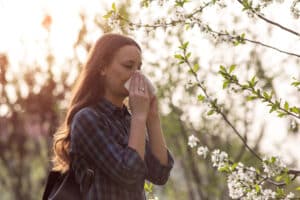 The warm, windy and dry Southern Nevada weather is a perfect setting for allergies. Our climate creates conditions for increased pollen counts and this results in classic allergy symptoms of congestion, runny nose, sneezing and itchy eyes. Common allergens in our area include olive, mulberry and elm trees. In addition, grass and weed pollen increase in Spring and Fall.
The warm, windy and dry Southern Nevada weather is a perfect setting for allergies. Our climate creates conditions for increased pollen counts and this results in classic allergy symptoms of congestion, runny nose, sneezing and itchy eyes. Common allergens in our area include olive, mulberry and elm trees. In addition, grass and weed pollen increase in Spring and Fall.
So, what steps can we take to limit our allergy problem?
1. Over the counter medications:
These include antihistamines such as Allegra and Zyrtec. Using a good saline nasal rinse or even spray is helpful to limit pollen activity. Nasal steroid sprays (Nasacort and Flonase) as well as nasal antihistamine sprays (Astepro) are helpful in reducing congestion and runny nose as well as sneezing. Antihistamine eye drops are helpful in managing itchy, irritated eyes.
2. Prescription medications:
Occasionally, oral steroids such as prednisone are useful in alleviating a more severe allergy condition. These should be used sparingly and on a short term basis. Antibiotics may be necessary when a secondary sinus infection is present.
3. Lifestyle changes:
Limiting outdoor activities during times of high pollen counts and keeping windows and doors closed are important measures. Taking a shower after being outdoors and changing clothes is helpful. Using HEPA filter air purifiers reduces pollen counts indoors as well.
4. Immunotherapy:
This consists of a program of “allergy shots” based on allergy skin testing that can help in reducing allergy symptoms and reactions over time. More recently, sublingual (under the tongue) allergy drops are available and can be administered at home.
Contact us today to learn more or schedule an appointment.